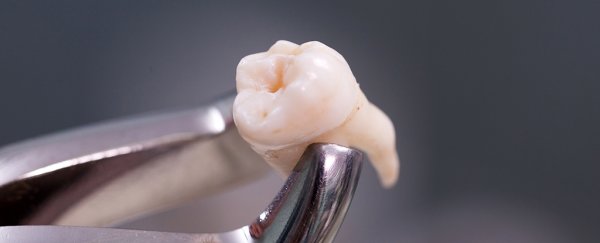A new study of the nanoscale particles making up tooth enamel has given scientists the closest look yet at what chewing and eating does to the hardest tissue in the human body - our teeth.
Specifically, the research looked at hydroxyapatite crystallites, the ribbon-like strings of nanoparticles that form enamel, putting them through a series of scratch and pressure tests to see how the nanoparticles held up at a highly detailed level.
The researchers from the US and China are hoping their findings could lead to improved dental care, as well as giving fossil hunters more of an insight into any ancient teeth they come across in their digs.
"Hydroxyapatite crystallites are the fundamental units of enamel, each less than one thousandth the thickness of a human hair," says one of the team, Peter Ungar from the University of Arkansas.
"Most research on tooth wear to date has focussed on effects at much larger scales, but we have to study enamel at this finer level to truly understand the nature of how the hardest tissue in our bodies resists wear and tear."
 Credit: University of Arkansas
Credit: University of Arkansas
Hydroxyapatite crystallites are stacked on top of each other and glued together with proteins to build enamel. To get a closer look, the team trained high-powered microscopes on real human molars extracted for orthodontic purposes.
The researchers moved diamond instrument tips across the teeth to scratch them, as well as applying pressure and indenting the surfaces of the teeth – intended to simulate chewing and biting respectively.
At every pressure level, scratching (chewing) caused more damage than indenting (biting). This means that grinding your teeth together is more harmful to the enamel than chomping down.
Three different types of damage were noted overall, both when scratching and when indenting. These were 'plucking', where crystallites get separated; 'deformation', where crystallites get bent and squeezed; and 'fragmentation', where the chemical bonds holding the crystallites are broken completely.
Up until now we haven't known much about the finer detail around how teeth respond to the loads we put on them, but here scientists were able to get right down to the actual nanochemical bonds between crystallites.
The images and measurements they gathered can be used in all kinds of fields, including dentistry, evolutionary biology, and biomedicine, according to the team. Eventually, it might even help us choose diets less harmful to our teeth.
And when we find teeth left by generations past, we could be able to work out more about their diet and eating patterns with the help of this new information.
Further down the line we could also use the data to take some cues from our own biology about how to make tough, damage-resistant surfaces.
"The findings in the surface tribological chemistry can help us understand the nature of the interfacial chemical bonding between the nanoparticles that Mother Nature uses to make biominerals of all types on demand," says one of the researchers, Ryan Tian from the University of Arkansas.
The research has been published in the Journal of the Royal Society Interface.
